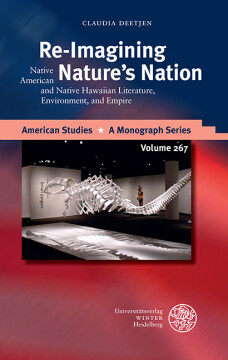
BUCH
Re-Imagining Nature’s Nation
Native American and Native Hawaiian Literature, Environment, and Empire
American Studies – A Monograph Series, Bd. 267
2016
Zusätzliche Informationen
Bibliografische Daten
Abstract
This book looks at contemporary Native American and Native Hawaiian environmentally-oriented literature that critically engages with the environmental dimensions of imperialism and colonialism both in the past and in the present. Situated in the fields of Indigenous Studies and postcolonial ecocriticism, it explores how Native American authors N. Scott Momaday and Leslie Marmon Silko, Gerald Vizenor, Diane Glancy and Blake Hausman as well as Native Hawaiian writer Kiana Davenport adapt Anglo-American forms of environmental writing in order to challenge discourses of the United States as ‘nature’s nation’ and make visible the profound transformations of American and world environments in the course of empires.
Inhaltsverzeichnis
| Zwischenüberschrift | Seite | Aktion | Preis |
|---|---|---|---|
| Cover | C | ||
| Title Page | 3 | ||
| Copyright | 4 | ||
| Acknowledgments | 5 | ||
| Contents | 6b | ||
| 1 Introduction | 7 | ||
| 2 Environment and Empire | 15 | ||
| 2.1 Postcolonial Ecocriticism | 15 | ||
| 2.2 Environmental Discourses and Colonialism | 25 | ||
| 2.3 NaturalCultural Contact Zones | 41 | ||
| 3 The Post-War Native American Novel | 49 | ||
| 3.1 The Homing-Plot Novel as Red Power Counter-Pastoral | 49 | ||
| 3.2 Trickster Earth: The Postmodern Native American Novel | 61 | ||
| 4 Counter-Pastoral Revisions | 79 | ||
| 4.1 Leslie Marmon Silko, "Gardens in the Dunes" | 79 | ||
| 4.1.1 Revisiting American Gardens | 81 | ||
| 4.1.2 Tracing the Routes of Species | 94 | ||
| 4.2 Kiana Davenport, "Shark Dialogues" | 102 | ||
| 4.2.1 Re-Writing Paradise | 104 | ||
| 4.2.2 Tracing the Routes of Species | 116 | ||
| 5 (Re-)Creating Trickster Earth | 127 | ||
| 5.1 Gerald Vizenor, "Dead Voices" | 127 | ||
| 5.1.1 Creating a New Wilderness in the City | 128 | ||
| 5.1.2 New Stories of Urban Survival | 145 | ||
| 5.2 Diane Glancy, "The Man Who Heard the Land" | 151 | ||
| 5.2.1 Reconciling Conflicting Narratives: Recovering Trickster Stories | 153 | ||
| 5.2.2 Hearing the Land | 162 | ||
| 6 "Riding the Trail of Tears": Blake Hausman’s Cyber Pastoral | 171 | ||
| 6.1 (Re-)Creating a Virtual ‘Motherland | 174 | ||
| 6.2 “Like Life Itself”: Inhabiting Virtual Environments | 192 | ||
| 7 Conclusion | 203 | ||
| 8 Bibliography | 207 |


 Publishing Platform by CloudPublish
Publishing Platform by CloudPublish